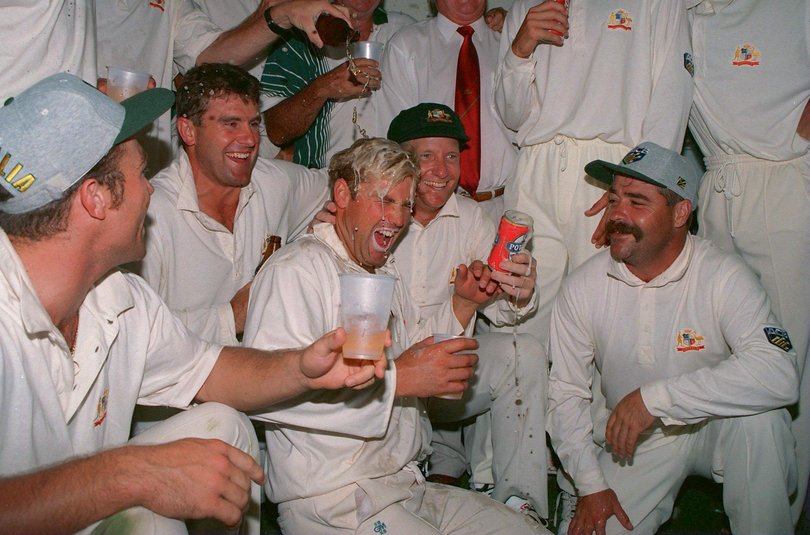GIDEON HAIGH: Why Test Cricket’s greatest rivalry continues to endure after 143 years
From time to time, people try to wean themselves off the Ashes.
The home ground advantage is too pronounced. The rivalry between India and Pakistan is more potent. The five-Test series is an anachronism.
All of which are arguable.
Sign up to The Nightly's newsletters.
Get the first look at the digital newspaper, curated daily stories and breaking headlines delivered to your inbox.
By continuing you agree to our Terms and Privacy Policy.The Ashes simply nods, smiles, thanks you for your time, and waits — it knows you’ll be back.
Because there’s no escaping it, really. Cricket’s calendar is tighter than a face on The Golden Bachelor.
But somehow there is always room for more Ashes. Sometimes we test the rivalry’s limits.
Remember the flogging of an incinerated horse that was the ten consecutive Ashes Tests of 2013-14? On Boxing Day 2013, the ninth game in the sequence, an unremarkable encounter in a dead rubber with whimpering visitors at the mercy of surging hosts, a world record crowd of 91,092 attended. As the joke runs, you had to be there.
This summer — especially if you’re English en route to Australia — optimism reigns.
England has not won on Australian soil for a dozen prime ministers — six Australian, six English — but omens somehow are in the air.
Mind you, few predictions are so perishable as those about the Ashes. They have been known to last a single delivery. A wicket, a wide or a boundary from the first ball can shiver the most confident and authoritative forecasts to fragments.
Australia v England is box office. It fills administrative coffers.
Why such anticipation? Australia v England is the template of sporting rivalry, round so long as to be a phenomenon its votaries are born into.
The Ashes started almost before the antagonists were ready. In 1882, not only was Australia still to become a country, but cremation was illegal in England.
Thus the joke, long-forgotten, perpetuated in their less-is-more trophy — cricket’s impossibly precious family heirloom, cultural immensity somehow magnified by physical smallness.
Time matters in a different sense also. These days, the familiar rapidly grows passe, and formulae are quickly worn out.
The Ashes happen just often enough. They burn brightly then glow long. The first day of the First Test in Perth marks 845 days since the last.
The not-playing is important because such hiatuses allow expectations to flourish. Relative performance gives way to fantasy match-ups, recency bias gives way to confirmation bias, magical thinking trumps common sense — because, to be fair, the Ashes is no stranger to outrageous fortunes.
In this, England is the key variant. Australia is always competitive. Not since 1977 has Australia failed to win a Test in an Ashes series. It’s their rivals who have proved truly mercurial, pulling off heists from Headingley 1981 to Headingley 2019 in between barely showing up.
In 2023, Ben Stokes’s team scaled rare heights of brilliance, pushing Pat Cummins’ team to the brink of their resourcefulness. It was, as the Duke of Wellington said of Waterloo,”‘a damn close run thing.”
Australian conditions present a steeper challenge. This summer will be more like Wellington’s line about battle as consisting of guessing “what is on the other side of the hill.”
The temptation is always to wonder in what state the rivalry finds the two countries. Australia and England are complexly and intimately related. Their people feel at home in each other’s countries, albeit that the general similarity has a way of magnifying small differences.

Cricket is integral to their shared heritage and also to their habits of contradistinction. From time to time, an English player will be said to play “like an Australian” — Tony Greig, Ian Botham, Stokes, all-action all-rounders — but not often.
No Australian player of any note has been said to play “like an Englishman”, even if some, from Richie Benaud to Shane Warne, have looked oddly comfortable in British settings.
Every time you think that their peculiar public hang-ups about one another may be fading, moreover, the Ashes demonstrates that atavism still lurks.
At the outset of the last Ashes, some of the gnarlier pundits thought it was all getting a bit friendly and relaxed. This lasted until the final epic day at Lord’s, when Alex Carey’s quick-thinking underarm caught an unsuspecting Jonny Bairstow wandering out of his ground, causing an outbreak of English pique and Australian affront.
It was, in a sense, the perfect Ashes contretemps, ticking the box of every conceivable stereotype. Aussies pushing the limits of fair play. Poms behaving as moral arbiters. Members of the club that make the game’s laws not knowing them and protesting Australian boorishness with their own.

It would not have been nearly such fun had Bairstow caught an Australian napping in similar circumstances — as indeed he had tried and failed to do. Had an Indian dismissed Bairstow, meanwhile, nobody would dared say boo.
Pretty soon everyone was enjoying the licence the Ashes affords to bray like an ass, with even the prime ministers getting in on it. It was actually Australia’s longest-serving prime minister, Sir Robert Menzies, who put it best: “We know each other so well that, thank Heaven, we don’t have to be too tactful with each other.”
Is the Ashes’ confidence in itself soundly placed? It’s worth remembering that it is sustained not merely by reverence and sentiment but by the sinews of finance.
Australia v England is box office. It fills administrative coffers. That lends it some but not total security — some day, no doubt, there’ll be brainstorms about privatising the Ashes, selling a slice to the Ambanis, staging it in Saudi Arabia or scaling it down for TikTok.
But, praise be, not yet. And if these five Test matches should live up even half-way to the hype, this summer might build that base of those who like it just the way it is.
